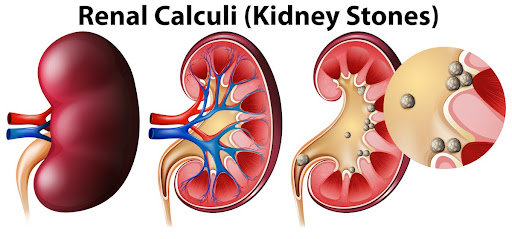At KCUC Urology and Oncology, we have many treatments for kidney stones. But, what causes kidney stones in the first place? What are the symptoms of a kidney stone? And what are the available treatments? Here’s a little kidney stone update.
What Are Kidney Stones?
The scientific name for a kidney stone is renal calculus or nephrolith. The condition is also called nephrolithiasis, urolithiasis, or urinary stones. These stones are basically made of minerals and salts that solidify in your body forming small hard crystals. They form inside your kidneys but can move to other parts of your urinary system including your kidneys, bladder, and urethra. It is when these stones move that they cause problems and we become aware of them.
What Are the Symptoms of Kidney Stones?
When kidney stones start to move and the body tries to pass them, you may experience any of these symptoms:
- Intense pain in your back or side near your kidney – pain may radiate towards your abdomen, groin, or genitals
- Nausea and/or vomiting
- Blood in your urine
- Frequent and painful urination
- Fever – this is considered a medical emergency as it signifies an infection that could progress to life-threatening sepsis
What Causes Kidney Stones
There are many things that cause kidney stones. What you eat and drink, being overweight, certain medical conditions and even some supplements and medications can all contribute to the formation of stones. Often, when the urine becomes concentrated from not drinking enough fluids, the minerals stick together forming small stones. Many times, kidney stones can be passed on their own without needing medical attention. They can be quite painful, but don’t usually cause any permanent damage. But sometimes, the stone gets stuck in the urinary tract and can cause inflammation and infection. When that’s the case, there are several options we can try.
Treatments for Kidney Stones
ESWL (Extracorporeal Shock Wave Lithotripsy)
During this treatment, a series of shock waves generated by a machine called a lithotripter are focused by x-ray onto the kidney stone and travel into the body through skin and tissue to reach the stone. They break it into small fragments making them easily passable through the urinary tract.
Ureteroscopy with Lithotripsy
This is an outpatient procedure that involves passing a small telescope, called a ureteroscope, through the urethra and bladder and up the ureter to the point where the stone is located. Then, a very small videoscope is passed into the urinary tract, where the stone can be grasped or broken into smaller pieces with a laser. Most often ureteroscopy is used for stones in the ureter, especially for stones closest to the bladder, in the lower half of the ureter. lt is the most common treatment of lower ureteral stones.
Percutaneous Nephrolithotomy
Percutaneous Nephrolithotomy is a surgical procedure in which the stone is removed directly from a patient’s kidney. A video scope is placed directly into the kidney through the skin in the side. An ultrasound or laser can then be used to break up and remove the stones. This is most effective for larger stones in the upper urinary tract.
Open Surgery
Open surgery to remove kidney stones is now a rare procedure. It is used when patients develop large or complex kidney stones that cannot be effectively removed with less invasive techniques like those described above.

